Yesterday (May 20th) , Tony Wileman, from the London Wildlife Trust, came to Crossness Nature Reserve to educate us on the wonderful world of wildflower identification.
Twelve people braved the dark skies and unexpected showers and learned tonnes by doing so.
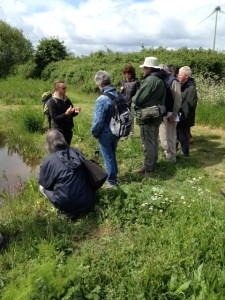
LWT’s Tony Wileman talking about some of the plants around the Protected Area pond. (Photo Karen Sutton).
At least 63 species were identified within just a small section of the Protected Area (list below in the order that they were seen, provided by diligent record-keeper Dave Sorrell; thank you Dave). These were not especially uncommon plants, and some had come up as part of seed mixes, but this event was about learning the basics rather than finding rarities.
Not only were we told what the plants were – common names as well as scientific names – but with many of them, we were also shown the diagnostic features that distinguish one species from another within the same family, and we were provided with a bit of folklore associated with certain wildflowers, as well as culinary and medicinal uses.
We had the pleasure of pulling up some Horseradish root, rubbing the base and sniffing it for a definite reminder of a beef roast. Something that was new to me (though perhaps shouldn’t have been) was that red and pink flowers are generally attractive to bees, whilst white flowers are often pollinated by moths, and yellow flowers are attractive to leaf beetles. We learned that Burdock inspired the creation of Velcro; that Plantains staunch blood, and Comfrey heals minor wounds; that Hemlock killed Socrates and that Cleavers, a bedstraw, was used historically to stuff mattresses and pillows, whilst only a noble Lady was permitted to use the softer Lady’s Bedstraw.
It was a fascinating and educational walk. Just as we started getting used to this flora ID malarkey, we also learned that there are hundreds of different species of Bramble (who knew??) and over 250 species of Dandelion!! Oh dear.
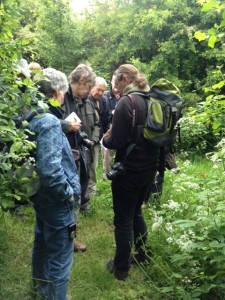
Attendees discussing the finer points of plant identification in the scrub area of the reserve. (Photo: Karen Sutton)
Horse-radish, Sea Beet, Corn Marigold, Cornflower ,Corncockle, Chamomile, Black Horehound, Fennel, Cow Parsley, Common Poppy, Long-headed Poppy, Shepherd’s Purse, Cut-leaved Crane’s-bill, Ribwort Plantain, Celery-leaved Buttercup, Common Bird’s-foot-trefoil, Red Clover, Teasel, Lucerne, Knotted Hedge-parsley, Spotted Medick, Smooth Sow-thistle, Hemlock, False Fox Sedge, Cleavers, Grey Willow, Bristly Oxtongue, Common Toadflax, Common Reed, False Oat-grass, Soft Brome Grass, Barren Brome Grass, Smooth Meadow-grass, Marsh Sow-thistle, Hawthorn, Cock’s-foot, Ground-elder, White Dead-nettle, Stinging Nettle, Hogweed ,Creeping Cinquefoil, White Bryony, Creeping Buttercup, Meadow Buttercup, Bramble, Oxeye Daisy, Yorkshire Fog Grass, Common Ragwort, Bindweed (Hedge or Large), Marsh Thistle, Elder, Creeping Thistle, Woody Nightshade, Amphibious Bistort, Spear Thistle, Broad-leaved Dock, Blackthorn, False-acacia, Burdock (Greater or Lesser), Russian Comfrey, Creeping Bent-grass, Hedge Mustard and Mugwort.
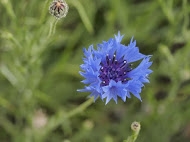
Cornflower, an arable ‘weed’ now rare in the countryside due to modern agricultural methods, had come up from a wildflower seed mix. (Photo: John Tolliday)
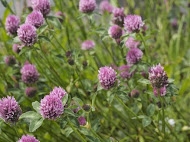
The flowerhead of Red Clover is made up of a number of individual ‘pea’ flowers, and is excellent for Bees. (Photo: John Tolliday)
Karen Sutton, Reserve Manager

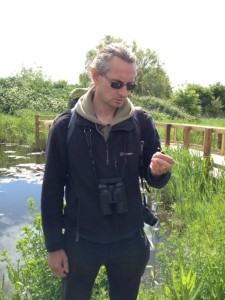
Thanks for comprehensive report & species list – I meant to come to this & completely forgot!